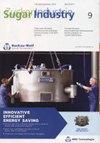A technical assessment of a new continuous ion exchange decolourisation plant at the Tongaat-Hulett Rossburg refinery
IF 0.2
4区 农林科学
Q4 FOOD SCIENCE & TECHNOLOGY
引用次数: 1
Abstract
The Tongaat Hulett sugar refinery in Durban has recently commissioned a continuous ion-exchange (CIX) plant which has become a third ion-exchange stage in its sugar refining process following the existing two fixed bed (FB) batch ion-exchange stages. The plant will initially be evaluated and optimised as a third polishing stage using styrenic resin but the design is such that the plant can be operated as any stage with either acrylic or styrenic resin. The installed CIX plant consists of 30 resin vessels containing 1.3 m3 of resin each and has been designed to process up to 180 m3/h of refinery liquor. At the heart of the CIX plant is the Tongaat Hulett / IONEX Separations RDA technology, which has several advantages over the conventional carousel-based continuous ion exchange systems. The plant was commissioned in November 2018 and has operated with time efficiency to date above 98%. The CIX plant has 61% less resin inventory than the Fixed Bed plant. The colour removal efficiency is comparable for both systems. The CIX plant is using 71% less water per day than the FB plant and consumes 65% less chemicals. The CIX plant is producing on average 67% less effluent and 85% less sweetwater than the FB plant per day. Part of this remarkable performance is linked to water recovery design that was incorporated into the CIX plant. Modelling of the CIX plant operating as a first ion exchange stage, showed that there would be 31% reduction in water usage compared to the current first stage and about 11% reduction in effluent generation.对汤加特-胡莱特罗斯堡炼油厂新建的连续离子交换脱色装置进行了技术评估
德班的Tongaat Hulett糖厂最近投入使用了一个连续离子交换(CIX)工厂,这是继现有的两个固定床(FB)间歇离子交换阶段之后,其糖精炼过程中的第三个离子交换阶段。该工厂最初将使用苯乙烯树脂作为第三个抛光阶段进行评估和优化,但设计是这样的,该工厂可以使用丙烯酸或苯乙烯树脂作为任何阶段运行。安装的CIX装置由30个树脂容器组成,每个容器含有1.3立方米的树脂,设计用于处理高达180立方米/小时的炼油液。CIX工厂的核心是Tongaat Hulett / IONEX分离RDA技术,与传统的旋转轮连续离子交换系统相比,该技术具有多项优势。该工厂于2018年11月投入使用,迄今为止的时间效率超过98%。CIX工厂的树脂库存比固定床工厂少61%。两种系统的除色效率相当。CIX工厂每天的用水量比FB工厂少71%,化学品消耗量少65%。与FB工厂相比,CIX工厂每天平均减少67%的污水和85%的甜水。这一卓越的性能部分与CIX工厂的水回收设计有关。CIX工厂作为第一阶段离子交换阶段运行的模型显示,与目前的第一阶段相比,用水量将减少31%,污水排放量将减少约11%。
本文章由计算机程序翻译,如有差异,请以英文原文为准。
求助全文
约1分钟内获得全文
求助全文
来源期刊

Sugar Industry-Zuckerindustrie
工程技术-食品科技
CiteScore
0.50
自引率
50.00%
发文量
22
审稿时长
18-36 weeks
期刊介绍:
Sugar Industry / Zuckerindustrie accepts original papers (research reports), review articles, and short communications on all the aspects implied by the journals title and subtitle.
 求助内容:
求助内容: 应助结果提醒方式:
应助结果提醒方式:


